It's what I used to do.
We typed up copy from the reporters and it would
come out in this code. We had to memorize the alphabet in the code;
because you had to be able to look back and read some of the tape if you
thought you made a mistake, or got up for some reason, came back to
your desk--you had to know where you left off. If you caught a mistake
or felt like you hit the wrong key, you could find the word, and just
blank out the mistake with all holes, then just continue
on typing. We typed in a continuous stream, hitting indicators to mean
bold face, or a new paragraph was beginning, etc..
We typed commands
such as "quad left, return", or right, or center, to indicate where the
lines should end up on the proof. We didn't relish sports columns, as we
had to add certain spaces, such as an en or an em space here and there,
to make sports columns of numbers line up correctly. Then we would
wind up the tape, as in the top pic, and feed it through a "computer"
the size of a refrigerator, and it would justify the lines, (spread out
the words as evenly as possible, so that the width of the column
remained even) then that justified tape would go to the linotype
department. When fed through the linotype machines the letters, numbers,
words would come out formed into the appropriate paragraphs, in hot
lead. That's what would be used to print on paper.
No one remembers
this procedure today, I'm sure. We would hit "shift" before a capital
letter, then "unshift" immediately after that, and continue on.
At
times the proofreader would be getting backed up a little and since we
also learned the proofreading marks, indicating changes to be made, such
as OSC (out, see copy, or take this word out, so that it matches the
original copy), or underlining a letter three times, would mean to
capitalize it, for instance. Little squiggles resembling an e in cursive
would mean to remove a letter. The proofreader was an older lady, sort
of the type you would cast in a movie as an old librarian. She had been
doing her job for years and didn't want any help from us (20
somethings).
Occasionally, we'd head over to help her proof some
copies, and she'd say "Oh no you don't, Girlie, I can do this myself."
She didn't trust any of us; but she had to accept help, as we were sent
over to help get things finished up. Lord knows we didn't really want
to sit next to her for 15 or 20 minutes with her critical, glaring eye
and her suspicions that we were just too young and inexperienced to do
her job. lol.
But we did it; and she was always glad when we left
after getting caught up, and we returned to our own department. Her name
was Bea.
Subscribe to:
Post Comments (Atom)

















No comments:
Post a Comment